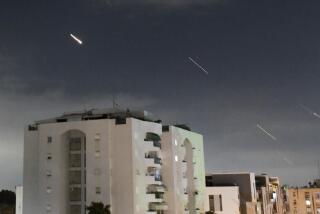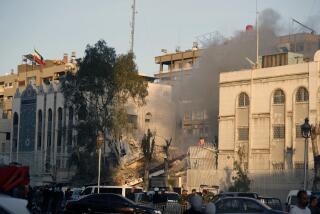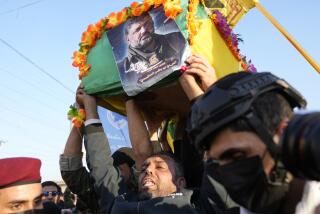From the archives: Hezbollah Seen Setting Up Terror Network in Africa
WASHINGTON -- In a secret campaign to spread its influence beyond Lebanon and Iran, the Shiite extremist group Hezbollah has established a network of operatives in West and Central Africa, an area that may be providing new bases for terrorist acts against Western nations, according to U.S. and French officials.
” Tehran’s reach now extends into Hezbollah communities in West Africa, and it seeks to duplicate there what it did in Lebanon,” said a U.S. official who has been monitoring the trend. Cells of the pro-Iranian Hezbollah, or Party of God, have been linked to a series of suicide bombings, hostage abductions and other terrorist activities in Lebanon since 1982.
The fears about Hezbollah’s expansion coincide with the disclosure in Spain on Saturday that a Party of God cell had tried to smuggle 18 pounds of plastic explosives hidden in jars of jam into Spain by ship through the port city of Valencia.
Spanish police said that 10 people were arrested. They are suspected of plotting to attack U.S. and other Western targets in Europe. Some carried Lebanese passports.
In West and Central Africa, the list of countries where Hezbollah is now active includes four with strong and longstanding relations with the West-- Ivory Coast, Senegal, Gabon and Zaire. Western intelligence officials also suspect that there are cells in other African countries.
The cells have taken root mainly among the tens of thousands of Shiite Lebanese emigres working in Africa, U.S. and French officials have said in interviews over the last three years.
France discovered the network when Paris briefly mediated through a Shiite Lebanese sheik based in West Africa while trying to win freedom for its hostages in Lebanon. But the depth of Hezbollah’s penetration in the region was not uncovered until after a bomb exploded in September aboard a French airliner as it was flying over Niger. The blast brought down UTA Flight 772, killing 171 people. French intelligence authorities now suspect that cells of pro-Iranian Shiite extremists played “a prominent role” in the bombing.
In recent months, the French have uncovered a series of security breaches at their embassies in Guinea, Gabon, Senegal and Tunisia involving the sale of passports and intelligence cables to Hezbollah cells.
The most serious breach occurred in Conakry, Guinea, where a French consular official provided 100 French identity cards and 60 French passports to a Shiite cell. The scheme was uncovered after a Lebanese carrying one of the French passports blew himself up with a homemade bomb in London last summer, according to French envoys in West Africa.
In Dakar, Senegal, a French Embassy employee was caught providing French identity cards to another group of Lebanese. In Brazzaville, Gabon, where UTA Flight 772 originated, the security breach involved the theft of French diplomatic cables.
Most of the French Embassy employees involved were contract workers who had served in Beirut or had Lebanese connections, according to French officials. Several have been arrested.
In addition to the French Embassy incidents, an arms cache linked to a Hezbollah cell was uncovered in Ivory Coast last year.
“We don’t believe the cells are being created to destabilize the countries they are in,” said a French official. “But all these countries offer bases for operations against the West.
“They are in the courtyard of Europe. And security is notoriously lax in West Africa.”
The French government believes that the false passports were obtained to facilitate freer passage to Europe. Both U.S. and French officials contend that the heightened security focus of Western intelligence agencies on Iran and Lebanon may have led to the creation of an alternative network for arms, personnel and access to Western targets in Third World countries not previously under suspicion.
U.S. and French officials now believe that the network has been building clandestinely since 1986. The movement reportedly centers around mosques and Shiite clerics espousing Islamic extremism to fight Western influence in the Third World as well as the Mideast.
“There has been a lot of proselytizing among Muslim communities throughout the world, including West Africa, since the Iranian revolution. In this context, the emergence of Hezbollah cells is not surprising,” a U.S. counterterrorism official said.
If Lebanon should return to law and order under the new reconciliation government, he added, “then it’s possible that they would shift the base of their activities to Shiite communities in West Africa. The real believers are not going to give up that easily.”
The U.S. official who has been monitoring the trend added, “The groups in West Africa have their own agendas, but they are also part of a broader movement with common anti-Western goals.”
Unlike other Middle East groups linked with terrorism, Hezbollah is not an organization with a rigid hierarchy or a controlled membership. Cells often proliferate on individual initiative or under the auspices of radical clerics. Hezbollah’s amorphous structure has made it difficult to trace, according to Western intelligence sources.
Initial investigations indicate that the main impetus for the African cells is from Lebanon rather than Iran.
“There is no proof yet that Iran is behind it,” said a State Department source. “But there has certainly been cheering among some Iranian officials,” specifically hard-liners angered by sporadic attempts since the mid-1988 end of the Persian Gulf War between Iran and Iraq to better Tehran’s relations with the West.
Iranian hard-liners are now publicly encouraging Hezbollah’s growth. Earlier this month, Mehdi Karrubi, Iran’s new Speaker of Parliament, called for “the formation of Hezbollah nuclei throughout the world in order to defend Muslims’ rights.”
Tehran also may have provided funding and other assistance, French and U.S. officials suggest. A key focus of current investigations is the money trail and the possible laundering of funds for operations elsewhere.
Most of the operatives appear to be Lebanese Shiites who for decades have been migrating to Africa to work. The indigenous Islamic communities in West and Central Africa are mainly Sunni Muslims.
An estimated 300,000 Lebanese Shiites now live in Ivory Coast, 30,000 in Sierre Leone, 20,000 in Senegal, 15,000 in Nigeria and 7,000 in Zaire, according to U.S. sources. But only a tiny percentage of these communities have been linked to Hezbollah activities.
There are smaller Lebanese Shiite communities in several other African nations. The attraction is generally better-paying jobs for a sect that has long been discriminated against by Christian and Sunni Muslim communities in Lebanon. Many work for years in West Africa, sending money back to families, and many eventually return to Lebanon.
Hezbollah’s West and Central African cells have also been difficult to penetrate because they have hooked into “strong and longstanding criminal activities” in the region, including smuggling, according to the U.S. counterterrorism official.
“Unraveling who is doing what and for what reasons has been a nightmare,” said a French official. “It makes understanding Lebanon look easy.”
Times staff writer Michael A. Hiltzik, in Africa, contributed to this story.
More to Read
Start your day right
Sign up for Essential California for news, features and recommendations from the L.A. Times and beyond in your inbox six days a week.
You may occasionally receive promotional content from the Los Angeles Times.






